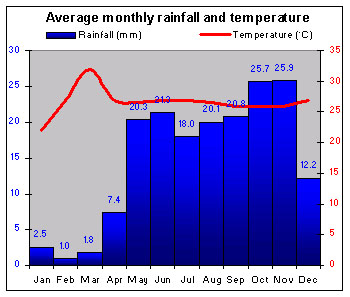COUNTRY INFORMATION |
Introduction |
Panama is the southernmost of the seven countries occupying the isthmus that joins North and South America. The rainforests of the southeastern Darien Peninsula are some of the wildest areas left in the Americas. Elected governments have held power since the US invasion of 1989. Panama's traditional economic strength is its banking sector. The USA returned control of the Panama Canal Zone to Panama on 31 December 1999. |
|
Climate |
 |
Panama has a humid tropical climate; rainfall is twice as heavy on the Caribbean coast as on the Pacific coast. |
|
People |
| Languages |
Spanish, English Creole, Amerindian languages, Chibchan |
|
| URBAN/RURAL POPULATION DIVIDE |
|
|
|
The northwest coast has a large black community, mostly descended from African immigrants who worked the plantations. The majority speak English Creole rather than Spanish. About 8% of the population are Amerindians mainly from the Guaymies, Chocoes, Kunas, and Ngobe-Buglé tribes. Roman Catholicism and the extended family remain strong, although the canal and the former US military bases have given society a cosmopolitan outlook. |
|
Economy |
| GNP (US$) |
9308
|
M |
GNP World rank |
87
|
|
| Inflation |
1 |
% |
Unemployment |
13 |
% |
|
StrengthsColón Free Trade Zone second-largest in world. Strong banking, financial, insurance, and other allied services. Banana, shrimp exports. Merchant shipping payments for sailing under the Panamanian flag. WeaknessesHistory of political instability and corruption. Large foreign debt. High unemployment, underemployment. Poor infrastructure. |
|
Politics |
| Lower house |
Last election |
1999 |
Next election |
2004 |
| Upper house |
Last election |
Not applicable |
Next election |
Not applicable |
|
In 1989, the USA invaded Panama and arrested its ruler, General Manuel Noriega, for narcotics smuggling. US forces installed the compliant Endara government, criticized for corruption. The 1994 presidential and legislative elections were won by Ernesto Pérez Balladares and the PRD, Noriega's old party, but the new government was largely pro-USA and its economic reforms attracted widespread discontent. A 1998 referendum denied Balladares a second consecutive term by 64% to 34%. In May 1999 opposition leader Mireya Moscoso of the PA was elected as Panama's first woman president. She promised social justice for the poor, but has followed an IMF-backed program and seen her popularity decline. |
|
Resources |
| Minerals |
Copper, coal, gold, silver, manganese, salt, clay |
|
| Oil reserves (barrels) |
No data |
Oil production (barrels/day) |
Not an oil producer; refines 100,000 b/d |
|
The Petaquilla area, west of the canal, has great copper and gold potential. To reduce the country's dependence on oil imports, the government has stepped up hydroelectric production; four state energy plants were privatized in 1999. Tropical hardwoods are being cut down at an alarming rate. |
|
Health |
| Life expectancy |
74 |
Life expect. World rank |
45 |
| Population per doctor |
688 |
Infant mortality (per 1000 births) |
20 |
|
|
|
| Principal causes of death |
Heart disease, cancers, violence, accidents, tuberculosis |
|
Primary health care is accessible to some two-thirds of the rural population. The isolation of many villages hinders efforts to improve the system. |
|
Education |
| Literacy |
92 |
% |
Expend. % GNP |
5 |
%
|
|
| PERCENTAGE OF POPULATION IN FULL TIME EDUCATION |
|
| Primary |
100 |
% |
Secondary |
69 |
% |
Tertiary |
32 |
% |
|
Schooling is based on the US model. Provision for the urban poor, blacks, and indigenous people is limited. |
|
Wealth |
| Cars |
83 |
per 1,000 population |
| Telephones |
151 |
per 1,000 population |
| Televisions |
194 |
per 1,000 population |
|
Wealth disparities are large. Almost 40% of the population are estimated to live below the poverty line – clustered in the cities rather than in rural areas.
|
History |
On independence from Spain in 1821, Panama was incorporated into Gran Colombia. Panama gained independence from Colombia with US support in 1903. - 1903 USA buys concession for Panama Canal.
- 1914–1939 Canal opens to traffic. US protectorate status ended.
- 1968–1981 Rule of Col. Torrijos Herrera.
- 1989 Indicted drug trafficker Gen. Noriega annuls elections to retain power. US invasion.
- 1994 PRD wins presidency and is largest party in parliament.
- 1999 PA's Mireya Moscoso elected first woman president. December, control of Canal Zone reverts from USA to Panama.
|
|